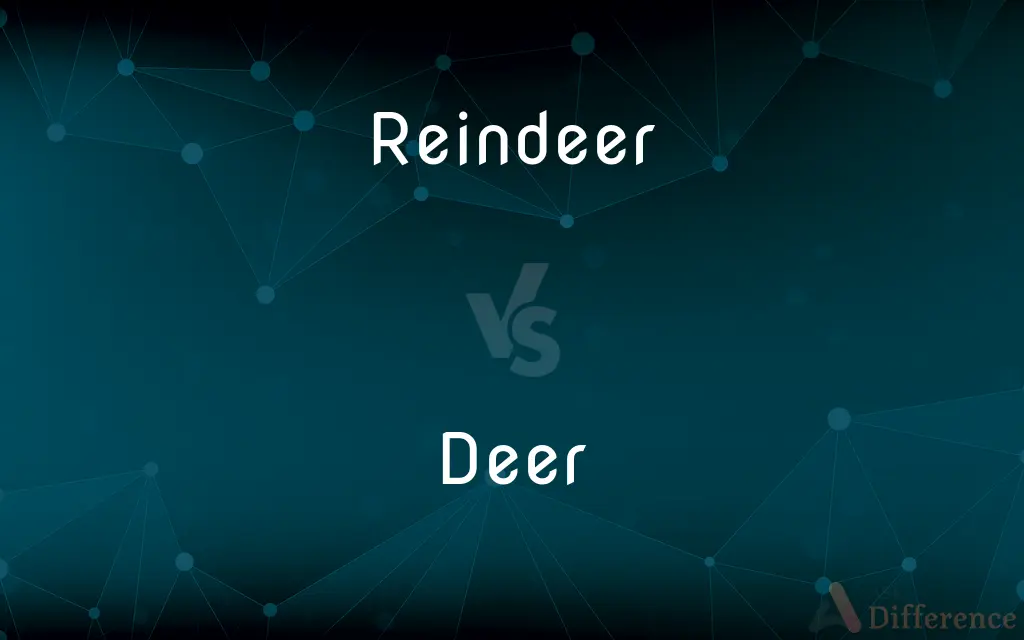Reindeer vs. Deer — What's the Difference?
By Tayyaba Rehman — Updated on October 13, 2023
Reindeer is a specific type of deer found mainly in arctic regions, whereas deer is a general term for a family of ruminant mammals, including various species.

Difference Between Reindeer and Deer
Table of Contents
ADVERTISEMENT
Key Differences
Reindeer and Deer, both belong to the Cervidae family, and while all reindeer are deer, not all deer are reindeer. Reindeer are specifically adapted to life in extreme cold environments like the arctic and subarctic regions. On the other hand, deer, as a broader category, includes various species that inhabit a wide range of environments from forests to grasslands worldwide.
Reindeer possess certain features that distinguish them from other deer. These include large, crescent-shaped hooves that provide stability on snow and ice, and a dense, woolly undercoat to insulate against harsh cold. Conversely, other deer species might have adaptations suited to their specific habitats, such as the white-tailed deer's agility and speed, making them proficient forest dwellers.
Another key difference lies in the fact that both male and female reindeer grow antlers. In contrast, in most other deer species, only the males grow antlers. This unique characteristic of reindeer sets them apart and showcases a distinct evolutionary trait.
Reindeer also have significant cultural and economic importance, particularly among indigenous Arctic communities. They are often domesticated for their meat, milk, and hides. While many deer species are hunted for sport or as a nuisance, few have the same level of domestication and utility as reindeer.
Comparison Chart
Geographical Range
Primarily Arctic and subarctic regions.
Worldwide, in various habitats.
ADVERTISEMENT
Physical Adaptation
Large hooves, dense undercoat for cold climates.
Varies by species; generally slender and agile.
Antler Growth
Both males and females grow antlers.
Mostly only males grow antlers.
Domestication
Often domesticated in Arctic regions.
Rarely domesticated.
Subspecies/Types
One main species with few subspecies.
Numerous species like white-tailed, mule, etc.
Compare with Definitions
Reindeer
Both males and females of this species grow antlers.
The female reindeer also had impressive antlers.
Deer
Most species are known for their agility.
The deer darted away at the first sign of danger.
Reindeer
A deer species adapted to Arctic and subarctic climates.
Reindeer are vital to Sami culture.
Deer
A ruminant mammal with antlers and hooves.
The deer gracefully jumped across the stream.
Reindeer
Have large, crescent-shaped hooves for snow.
The reindeer's hooves are well-suited for snowy terrains.
Deer
Belongs to the Cervidae family.
Many species fall under the deer category.
Reindeer
Often domesticated by Arctic indigenous populations.
The community herded their reindeer across the tundra.
Deer
Typically herbivorous, eating a range of plants.
The deer was spotted grazing in the meadow.
Reindeer
The reindeer (Rangifer tarandus), also known as caribou in North America, is a species of deer with circumpolar distribution, native to Arctic, subarctic, tundra, boreal, and mountainous regions of northern Europe, Siberia, and North America. This includes both sedentary and migratory populations.
Deer
Males of most species grow and shed antlers annually.
The buck's antlers were a majestic sight.
Reindeer
A large deer (Rangifer tarandus) of the Arctic tundra and northern boreal forests, having large hooves and long branched antlers, and widely domesticated in Eurasia. Subspecies native to North America and Greenland are usually called caribou.
Deer
Deer or true deer are hoofed ruminant mammals forming the family Cervidae. The two main groups of deer are the Cervinae, including the muntjac, the elk (wapiti), the red deer, the fallow deer, and the chital; and the Capreolinae, including the reindeer (caribou), the roe deer, the mule deer, and the moose.
Reindeer
(plural: reindeer) Any Arctic and subarctic-dwelling deer of the species Rangifer tarandus, with a number of subspecies.
Deer
Any of various hoofed ruminant mammals of the family Cervidae, characteristically having deciduous antlers borne chiefly by the males. The deer family includes the white-tailed deer, elk, moose, and caribou.
Reindeer
Any species, subspecies, ecotype, or other scientific grouping of such animals.
Deer
A ruminant mammal with antlers and hooves of the family Cervidae, or one of several similar animals from related families of the order Artiodactyla.
Reindeer
To herd or farm reindeer
Deer
(in particular) One of the smaller animals of this family, distinguished from a moose or elk
I wrecked my car after a deer ran across the road.
Reindeer
Any ruminant of the genus Rangifer, of the Deer family, found in the colder parts of both the Eastern and Western hemispheres, and having long irregularly branched antlers, with the brow tines palmate.
Deer
The meat of such an animal; venison.
Oh, I've never had deer before.
Reindeer
Arctic deer with large antlers in both sexes; called reindeer in Eurasia and caribou in North America
Deer
Any animal, especially a quadrupedal mammal as opposed to a bird, fish, etc.
Reindeer
Possess a dense undercoat for insulation.
The reindeer's fur keeps it warm in freezing temperatures.
Deer
Any animal; especially, a wild animal.
Mice and rats, and such small deer.
The camel, that great deer.
Deer
A ruminant of the genus Cervus, of many species, and of related genera of the family Cervidæ. The males, and in some species the females, have solid antlers, often much branched, which are shed annually. Their flesh, for which they are hunted, is called venison.
Deer
Distinguished from Bovidae by the male's having solid deciduous antlers
Common Curiosities
Where are reindeer primarily found?
Reindeer are mainly found in Arctic and subarctic regions.
What is the significance of reindeer to Arctic communities?
Reindeer are often domesticated for meat, milk, hides, and transportation by Arctic communities.
How many deer species are there?
There are multiple species of deer worldwide, such as white-tailed deer, mule deer, and more.
What do deer typically eat?
Deer are herbivores, typically eating a mix of grasses, plants, and shrubs.
Are reindeer a type of deer?
Yes, reindeer are a specific species of deer.
Are deer found worldwide?
Yes, deer species inhabit various environments worldwide.
Do deer shed their antlers?
Male deer of most species grow and shed their antlers annually.
Do only male deer grow antlers?
In most deer species, only males grow antlers. However, both male and female reindeer grow antlers.
Are all deer species as large as reindeer?
No, the size of deer varies widely among species.
What's the primary habitat of reindeer?
Reindeer predominantly inhabit tundras and cold regions.
Why do reindeer have a dense fur?
Reindeer have dense fur to insulate them from the extreme cold.
Is it true that reindeer hooves are adapted to snow?
Yes, reindeer have large, crescent-shaped hooves for stability on snow.
Can reindeer be domesticated?
Yes, particularly in the Arctic regions, reindeer are often domesticated.
Share Your Discovery

Previous Comparison
Cache vs. RAM
Next Comparison
Sunni vs. ShiaAuthor Spotlight
Written by
Tayyaba RehmanTayyaba Rehman is a distinguished writer, currently serving as a primary contributor to askdifference.com. As a researcher in semantics and etymology, Tayyaba's passion for the complexity of languages and their distinctions has found a perfect home on the platform. Tayyaba delves into the intricacies of language, distinguishing between commonly confused words and phrases, thereby providing clarity for readers worldwide.














































